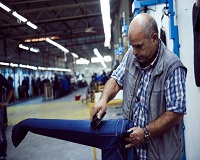"Worldwide, approximately 80 billion garments are produced annually, which is equivalent to 11 pieces of clothing per person, per year. At the same time, the number of worn clothes being discarded is also growing. In Shanghai alone, hundreds of tons of garments are being discarded every day, equating to 130,000 tons a year. Denim manufacturers for the world’s top brands have steadily grown in Xintang, a town in the province of Guandong, where 60 per cent of China’s jeans are produced. Studies reveal, 260 million pairs of jeans were produced in Xintang in 2008 alone for export to Russia, the United States, and the European Union."
 Worldwide, approximately 80 billion garments are produced annually, which is equivalent to 11 pieces of clothing per person, per year. At the same time, the number of worn clothes being discarded is also growing. In Shanghai alone, hundreds of tons of garments are being discarded every day, equating to 130,000 tons a year. Denim manufacturers for the world’s top brands have steadily grown in Xintang, a town in the province of Guandong, where 60 per cent of China’s jeans are produced. Studies reveal, 260 million pairs of jeans were produced in Xintang in 2008 alone for export to Russia, the United States, and the European Union.
Worldwide, approximately 80 billion garments are produced annually, which is equivalent to 11 pieces of clothing per person, per year. At the same time, the number of worn clothes being discarded is also growing. In Shanghai alone, hundreds of tons of garments are being discarded every day, equating to 130,000 tons a year. Denim manufacturers for the world’s top brands have steadily grown in Xintang, a town in the province of Guandong, where 60 per cent of China’s jeans are produced. Studies reveal, 260 million pairs of jeans were produced in Xintang in 2008 alone for export to Russia, the United States, and the European Union.
While jeans registered the highest annual growth in 2017 since 2013 with over $95 billion in sales worldwide and the sales of premium designer jeans have doubled, there’s a dark side to it too. A recent documentary revealed one pair of jeans from Xintang sells for less than $11, yet 490,000 laborers depend on the factories for their livelihoods.
Denim garment business in Xintang began in 1980s and has been booming ever since. Factory workers can be seen everywhere in the town — mostly females — and some minors under 10 years. For tasks such as cutting thread, workers can earn 15 cents per piece or about $4 per day. In many factories, the machines never stop and workers rotate on shifts, six days a week. The rooms are noisy, hot, and humid and pungent with the smell of chemicals and dust, because the fans of heavy duty machines have not been cleaned in years, and the ventilation system is outdated. Such has been the plight of people working in the factories for many years.
Environmental implications
Every morning, workers must scoop the stones that are used to polish the jeans out of the wastewater, causing their fingers to turn blue from the toxic dyes and carcinogenic chemicals. This wastewater from the dying and polishing procedures is then discharged into the environment without any filtering or treatment. An investigation by Greenpeace in 2010 found at three sampling sites in Xintang, the amount of lead, copper, and cadmium in the riverbed exceeded the national soil quality standards, with one sample of river mud containing cadmium at levels that were 128 times over the safe limit. Blue plastic buckets filled with various chemical concoctions used in the intensive washing of the denim are stored in the factories’ washing departments. The jeans are washed over and over again to achieve the desired effect — sometimes up to 20 times. Carcinogenic substances from the chemicals become embedded in the denim and are slowly released, harming the health of the factory workers and potentially the consumers.
chemicals. This wastewater from the dying and polishing procedures is then discharged into the environment without any filtering or treatment. An investigation by Greenpeace in 2010 found at three sampling sites in Xintang, the amount of lead, copper, and cadmium in the riverbed exceeded the national soil quality standards, with one sample of river mud containing cadmium at levels that were 128 times over the safe limit. Blue plastic buckets filled with various chemical concoctions used in the intensive washing of the denim are stored in the factories’ washing departments. The jeans are washed over and over again to achieve the desired effect — sometimes up to 20 times. Carcinogenic substances from the chemicals become embedded in the denim and are slowly released, harming the health of the factory workers and potentially the consumers.
It’s estimated that 960 gallons of water is used for each pair of blue jeans produced. The wastewater, black, blue, or red in colour, is washed into rivers, where pollution has reached alarming levels. Some wastewater flows directly into the small local rivers and eventually flows to the Dongjiang River. Farmers near the river suffer from the stench of the water every day, as well as its pollution to their land and the effects on their crops. Using Google Map’s satellite view, one can see black waters from Dongjiang River near Dadun Village in Xintang flowing into the sea.












